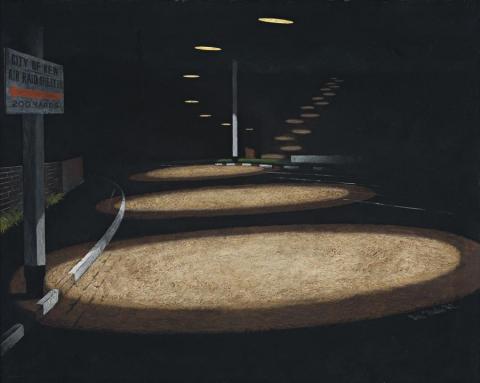BROWNOUT, 1942
ERIC THAKE
oil on pulpboard
41.0 x 51.0 cm
signed and dated lower right: Eric Thake ‘42
inscribed on backing verso: BROWNOUT / Eric Thake 1942 / Painted from Harp of Erin, East Kew
State Electricity Commission, Melbourne (inscribed verso)
Private collection
Sotheby's, Melbourne, 22 April 1996, lot 19
Private collection, Melbourne
Eric Thake: A Retrospective Exhibition, National Gallery of Victoria, Melbourne, 21 May – 4 July 1970, cat. 20
Smith, B., 'Some Aspects of Contemporary Art in Australia: 1943', in The Critic as Advocate, Selected Essays 1941–1988, Oxford University Press, Melbourne, 1989, p. 23 Eric
Eric Thake is a master of the unexpected. The Kamiri Searchlight 1944, an upside down self portrait mirrored in a searchlight, and the An Opera House in Every Home 1972, the Sydney Opera House in plates and saucers stacked on the kitchen sink, are among his best.1 There is even a 1957 photograph of a petrol pump changed into a bushranger through the eye of Thake's camera. A unique sense of humour and clever line give his art its engaging singularity. By the time he painted Brown Out 1942 Thake was at the height of his creativity. In 1941 he had shared with James Gleeson the Contemporary Art Society's prize, his winning painting, Salvation from the Evils of Earthly Existence 1940 and Gleeson's We Inhabit the Corrosive Littoral of Habitat 1940 being acquired by the National Gallery of Victoria. By now a fully fledged Surrealist, in Brown Out he used his considerable sense of design to serve a witty end in a play on words and ambiguities. The brown out was a protective measure taken during World War II, not as drastic as the black out, but creating an eerie effect nonetheless.2 The severe reduction of night lighting changed the familiar into the unfamiliar. It was just the kind of phenomenon to appeal to Thake, who inclined throughout his art to see the unusual in the everyday and the not so commonplace. He wrote, 'What one needs is a receptive mind open to the possibilities of design in familiar things, and it is very often the unlikely or accidental combinations of these things that act as a strong spur to the imagination and produces something really out of the box.'3 Brown Out is a classic example. The darkened scene is charged with dramatic effects through the transformation of the reflecting lights into something strange and otherworldly. Lights above recess into the picture's unfathomable darkness as everything seems to float, even the curbing to the far left. In Thake's hands these wartime precautions caused the real to become the super real, a science fiction fantasy of the terrestrial touched by the extra terrestrial. Painted from the Harp of Erin Hotel on the corner of Harp Rd and High St, East Kew, the sign to the left, reading that the City of Kew air raid shelter is 200 yards away, refers, no doubt, to the public shelter built in 1939. Thake was living in East Kew at this time. From 1944 to 1946 Thake worked as a war artist in the South West Pacific Area continuing to produce works like our painting. Never before in Australian art had there been such a felicitous marriage of the imaginative with the prosaic.
1. The watercolour Kamiri Searchlight 1944 is in the collection of the National Gallery of Australia, Canberra. The linocut An Opera House in Every Home 1972, is in many public and private collections.
2. The subject interested other artists too. See Country Brownout 1943 by Russell Drysdale (private collection).
3. Thake, E, 'On Getting Some Ideas for Pictures', typewritten notes for a talk at the 'Medical Art Society Exhibition', Victorian Artists' Society Gallery, 12 September 1963, p. 3, Eric Thake Papers, MS 9826, State Library of Victoria, Melbourne.
DAVID THOMAS
